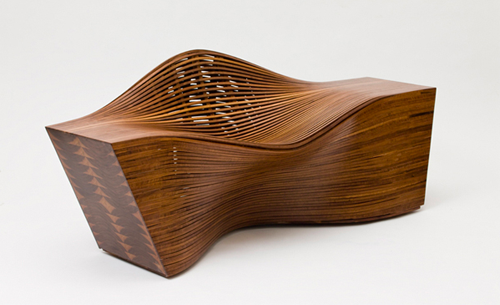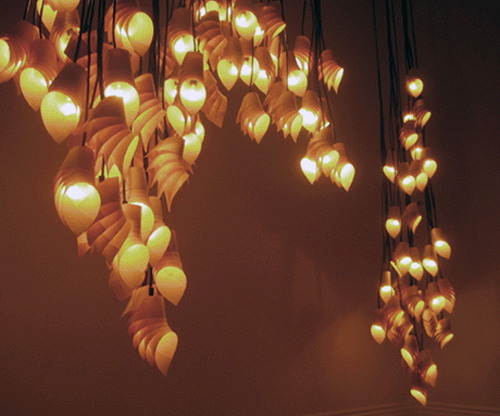 it’s ironic that the world’s first floating dining room is built on a bed of plastic bottles.
it’s ironic that the world’s first floating dining room is built on a bed of plastic bottles.
The surprisingly spacious dining area sits on a reclaimed pinewood frame that houses 1700 plastic bottles and can accommodate 12 guests for a 6-course sustainable seafood meal. It’s ironic by intention, of course. Designer Shannon Ronalds is trying to make a point.




Ronalds, founder of The School of Fish Foundation, is using the floating restaurant to educate chefs on the seafood industry and the impact that discarded plastic has on the ocean environment. All proceeds from the meal go to supporting the School of Fish’s education initiatives, like Shannon’s mission to make comprehensive sustainable seafood courses a requirement for graduation and providing schools with scientific data from marine conservation organizations. These initiatives are especially relevant now that the ocean has far more than just plastic bottles to contend with thanks to the Gulf oil spill, and chefs will have to make increasingly informed decisions when it comes to planning a seafood-based menu.
designer: shannon ronalds

about perrin drumm
 for parents drawn by the vintage appeal of the classic pram, but who want more functionality out of their expensive baby stroller, all hail the seed.
for parents drawn by the vintage appeal of the classic pram, but who want more functionality out of their expensive baby stroller, all hail the seed.


above: the pram comes with many accessories. even skis.
Part old-fashioned pram, part super modern stroller, the Seed is the latest from the great wide world of Scandinavian design, paying homage to a classic look without compromising on performance. It’s easy to fold up and tuck away and unlike it’s only-black predecessor, the Seed comes eight colors.
Price: about $1,300 USD
producer: seed

about perrin drumm
 marcus hays, founder and designer of pimobility, has hit on something pretty special with his electric-hybrid bike, the picycle.
marcus hays, founder and designer of pimobility, has hit on something pretty special with his electric-hybrid bike, the picycle.

The bright red, swooping frame immediately grabs your attention, and its statistics, like the fact that it produces zero-emissions, hooks you. The $3,000 – $5,000 price tag may put you off, and it’s certainly not for everyone, but when you consider that the yearly operating cost is almost nil, it ends up balancing out, saving you thousands that you would ordinarily spend on gas and maintenance for a car.
While it can’t boast the speed of a car, for getting around the city you couldn’t ask for a better ride. The Picycle reaches up to 30 mph (although the legal speed for electric bikes is 20 mph in most states) and runs for about 20 miles on a single charge. It uses a Lithion-ion battery, which is housed in the arcing aluminum frame, and takes only 2.5 hours to charge. You can ride it like a plain old bike, with electric-assist or completely under electric propulsion. Not having to pedal up a hill or in the heat means that if you’re someone who uses their bike to commute to and from work, no more arriving to work in a sweat-soaked dress shirt. And for the weekend joy-ride or trip to the beach, there’s no more sitting in traffic or stopping to tank up.
Pi electric bikes price: $2,999 to $4,999.
designer: marcus hays
producer: pimobility

about perrin drumm
 Blink, the new Electronic Vehicle (EV) Charger from ECOtality and Frog Design makes GE’s heretofore popular WattStation look like last year’s PC.
Blink, the new Electronic Vehicle (EV) Charger from ECOtality and Frog Design makes GE’s heretofore popular WattStation look like last year’s PC.

Its simple, rounded, white interface was designed to put the Mac-friendly world at ease, and its two-part configuration makes it ideal for use at home. Unlike the familiar gas station pump of a single, standing module, Blink separates the two components of the design into an upper communications-based section and a lower section that houses the charger. It evens tracks your “charging behavior” and notifies you when it’s peak charging time. And instead of a space-wasting, free-standing unit, Blink can be wall-mounted anywhere in your garage. Going EV never looked so good.
designer: frog design
producer: ecotality and wattstation

about perrin drumm
 the uk architecture firm groves-raines recently snagged first place in craftsmanship at the annual aia excellence in design award for their innovative use of re-bar in a compost shed in edinburgh.
the uk architecture firm groves-raines recently snagged first place in craftsmanship at the annual aia excellence in design award for their innovative use of re-bar in a compost shed in edinburgh.

With all the other awards this year going to large-scale projects, it’s important to highlight the smaller but important contributions to design.
The bending, sinewy lines of the rusted metal cords look elegant, calling to mind Richard Serra’s undulating marvels of bent steel. Let’s not overlook the hidden beauty the firm discovered in a material that usually plays a hidden role, and how they turned something that’s all about function into something that’s all about form.
[
aia 2010 excellence in design winners]
designer: groves-raines

about perrin drumm
 ask pieke bergmans a simple question and you’ll get anything but a simple answer.
ask pieke bergmans a simple question and you’ll get anything but a simple answer.
To the Dutch designer, a light bulb is not a light bulb. When a light bulb, or indeed any simple object, is placed under her personal design imperative, “Design Virus,” it becomes something else altogether. “A light bulb,” she says, “is a light bulb that has gone way out of line. Infected by the dreaded Design Virus, these bulbs have taken on all kinds of forms and sizes you wouldn’t expect from such well behaving and reliable little products.”


The same goes for everything else she designs from tables and cabinets to dinnerware and vases. Still, the Light Bulb series remains her most eye-catching work, garnering plenty of oohs and ahhs at Art Basel this year. The bulbs themselves are made of crystal, but Bergmans has also experimented with glass blowing to create some pieces that look particularly infected by the virus.
designer: pieke bergmans

about perrin drumm
 bae sehwa fits into that small gap between furniture design and art.
bae sehwa fits into that small gap between furniture design and art.
When he presented his work at this year’s Art Basel, he was known as an artist, but Sehwa himself prefers the term ‘furniture artist.’ He first made a name for himself with his series of Lighting Tables that look like plain birch wood until you plug them in to reveal the pattern underneath.
His recent work, however, leans towards more craft-based, one-of-kind furniture, made entirely out of wood. The work that blew away the crowds at Art Basel are from his Steam series that includes lighting and “sittable” pieces made from bent wood.
designer: bae sehwa
 about perrin drumm
about perrin drumm
 classic design is always in style, but have you found yourself wondering which of your bauhaus or mid-century favorites are still in production, and if so, where you can get them?
classic design is always in style, but have you found yourself wondering which of your bauhaus or mid-century favorites are still in production, and if so, where you can get them?
above: frank gehry’s wiggle side chair

above: george nelson’s home desk

above: george nakashima’s straight chair

above: marcel breuer’s wassily lounge chair
The answer to that is Edition20, a searchable database of all the best 20th-century goods that are still being produced under their original license. No links to knock-off manufacturers or reproductions or vintage classics that are no longer made.
The site itself is straightforward, easy to navigate and totally addictive. Even the most lukewarm design interest will be sparked by the labyrinthine path sure to ensue after the first click. George Nelson’s 1958 Home Desk by Vitra leads you to Frank Gehry’s 1972 Wiggle Side Chair, which leads you to his other work for Knoll, which can lead you to anything from George Nakashima’s 1948 Straight Chair to Marcel Breuer’s 1928 Wassily Lounge Chair to any of the famous pieces by Harry Bertoia, Mies van der Rohe or Eero Saarinen. And that’s just the chairs. For serious research or just a midday diversion, Edition20 satisfies.
Resources:
edition20
george nelson’s home desk
frank gehry’s wiggle side chair
george nakashima’s straight chair
marcel breuer’s wassily lounge chair

about perrin drumm
 it’s ironic that the world’s first floating dining room is built on a bed of plastic bottles.
it’s ironic that the world’s first floating dining room is built on a bed of plastic bottles.
































